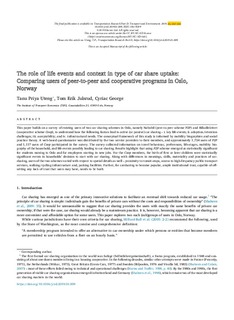| dc.contributor.author | Priya Uteng, Tanu | |
| dc.contributor.author | Julsrud, Tom Erik | |
| dc.contributor.author | George, Cyriac Manapurathu | |
| dc.coverage.spatial | Norway | nb_NO |
| dc.date.accessioned | 2019-07-04T12:46:19Z | |
| dc.date.available | 2019-07-04T12:46:19Z | |
| dc.date.created | 2019-04-16T16:31:33Z | |
| dc.date.issued | 2019-01-25 | |
| dc.identifier.citation | Transportation Research Part D: Transport and Environment. 2019, 71 (June), 186-206. | nb_NO |
| dc.identifier.issn | 1361-9209 | |
| dc.identifier.uri | http://hdl.handle.net/11250/2603431 | |
| dc.description.abstract | This paper builds on a survey of existing users of two car sharing schemes in Oslo, namely Nabobil (peer-to-peer scheme P2P) and Bilkollektivet (cooperative scheme Coop), to understand how the following factors lead to active (or passive) car sharing – i. key life-events; ii. adoption/retention challenges; iii. acceptability; and iv. infrastructural needs. The conceptual framework of this study is informed by mobility biographies and social practice theory. A web-based questionnaire was distributed by the two service providers to their members, and approximately 1,724 users of P2P and 1,117 users of Coop participated in the survey. The survey collected information on travel behaviour, preferences, life-stages, mobility biography of the household, and life-events possibly leading to car sharing. Results highlight that using P2P scheme emerged as statistically significant for students moving to Oslo and for employees starting in new jobs. For the Coop members, the birth of first or later children were statistically significant events in households’ decision to start with car sharing. Along with differences in meanings, skills, materiality and practices of carsharing, users of the two schemes varied with respect to spatial details as well – proximity to transit-stops, access to high-frequency public transport services, walking/cycling infrastructure and, parking facilities. Further, for carsharing to become popular, ample institutional trust, capable of off-setting any lack of trust that users may have, needs to be built. | nb_NO |
| dc.language.iso | eng | nb_NO |
| dc.publisher | Elsevier | nb_NO |
| dc.rights | Attribution-NonCommercial-NoDerivatives 4.0 Internasjonal | * |
| dc.rights.uri | http://creativecommons.org/licenses/by-nc-nd/4.0/deed.no | * |
| dc.title | The role of life events and context in type of car share uptake: Comparing users of peer-to-peer and cooperative programs in Oslo, Norway | nb_NO |
| dc.type | Journal article | nb_NO |
| dc.type | Peer reviewed | nb_NO |
| dc.rights.holder | © 2019 Elsevier Ltd. All rights reserved. | nb_NO |
| dc.description.version | acceptedVersion | nb_NO |
| cristin.unitcode | 7482,1,2,0 | |
| cristin.unitcode | 7482,1,1,0 | |
| cristin.unitcode | 7482,1,5,0 | |
| cristin.unitname | Byutvikling og bytransport | |
| cristin.unitname | Reisevaner og mobilitet | |
| cristin.unitname | Marked og styring | |
| cristin.ispublished | true | |
| cristin.fulltext | postprint | |
| cristin.qualitycode | 2 | |
| dc.identifier.doi | 10.1016/j.trd.2019.01.009 | |
| dc.identifier.cristin | 1692981 | |
| dc.source.journal | Transportation Research Part D: Transport and Environment | nb_NO |
| dc.source.volume | 71 | nb_NO |
| dc.source.issue | June | nb_NO |
| dc.source.pagenumber | 186-206 | nb_NO |
| dc.relation.project | Norges forskningsråd: 255430 | nb_NO |
| dc.relation.project | Nordisk Energiforskning: 77892 | nb_NO |

